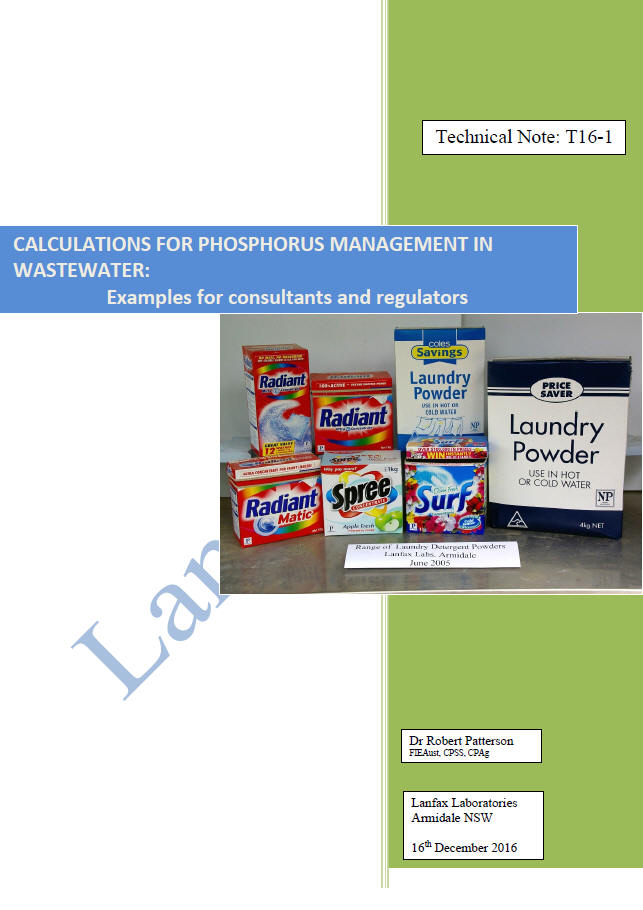Calculations for phosphorus management in wastewater
Let's clear up the spelling of phosphorus - the element, symbol P. With an atomic number of 15 and atomic weight of 30.97, it is one of the non-metals together with carbon, nitrogen, oxygen, sulphur and selenium. It is never found in the pure state because it is highly reactive with air. Most of the chemicals containing phosphorus are 'phosphates' - one phosphorus atom combined with four oxygen atoms as an anion with three spare electrons. The spelling of the reduced form of the element is phosphorous, as in phosphorous acid - that is it is no longer the element having gained one electron.
When we refer to compounds of phosphorus, as phosphates or orthophosphates, various P acids and others, it is usual just to use the term phosphorus to include any of these compounds when discussing wastewater issues.
ESSENTIAL TO LIFE: We need to understand that phosphorus is an essential element to life (animals, plants and micro-organisms)- generally in the form of phosphate (PO43-), as a transporter of energy, as structural components of all cellular membranes and in bones. Not only do we require a renewal of phosphorus in our diet for the phosphorus we excrete/defecate daily, we also retain phosphorus in our living body for biological and metabolic functions.
OUR WASTES: Phosphorus is excreted in urine and faeces at about 1-3 grams per adult per day into our toilet wastewater, from the wastes of food preparation in the kitchen, from detergents in the laundry and from personal care products in the bathroom. All natural foods have some phosphorus while processed foods may have a higher proportion of phosphorus, added as flavouring, preservatives, colour stabilisation and increased self life. Perhaps the best example of an excess of phosphorus is from the carbonated beverage industry where phosphoric acid is used to 'sharpen' the flavour and reduce mould and bacteria growth.
REDUCING PHOSPHORUS IN WASTEWATER: While our diet certainly contains phosphorus (in meat, grains and plants), not many households are eager to change their diet to limit phosphorus in wastewater. In the kitchen, reducing the waste in food preparation by removing the food peelings, wasted food, plate scrapings and other sources for disposal to the chooks, or for composting is recommended. In the laundry, the use of low phosphate or no-phosphate detergents, labelled 'P' and 'NP' respectively is quite easy to achieve, since most laundry products are identified as such (refer to phosphorus in laundry products). In the personal care items, labelling does not generally address the issue of phosphates, however, the small amounts in these products are probably not worth the investigation required.
PHOSPHORUS IN THE ENVIRONMENT: Phosphorus from wastewater treatment, either on-site systems or reticulated sewerage schemes, that enters natural waterways has the potential to encourage the proliferation of algae and cyanobacteria ('blue-green algae'), which when these decay consume oxygen from the water and suffocate aquatic life. Either chemical removal of the phosphorus or land application of the effluent is required, For the domestic on-site system, the land application area needs to have the capacity to consume the phosphorus, as plant nutrients, or immobilise the phosphorus through natural soil phosphorus sorption properties.
The attached document is a technical note discussing the calculations required to correctly size a land application area. It further discusses some of the misunderstandings conveyed in government guidelines that completely confuse an otherwise simple arithmetic calculation.

This document can be downloaded as a PDF file
Citation for document:
Patterson, R.A. (2016) Calculations for Phosphorus Management in Wastewater: Examples for consultants and regulators. Accessed (date) from http://www.lanfaxlabs.com.au/soil_phosphorus.htm
(Click here to download eight page document)
Table of Contents
1. Introduction
2. Questions and Calculations
3. Concentration versus Load - which is correct?
4. Unsupported Assumptions about Life of Land Application Area
5. Measurement of Phosphorus Sorption Capacity
6. P in Wastewater
7. Uptake of Phosphorus by Plants
8. Improving Soil Phosphorus Sorption Capacity
9. Conclusion
10. References